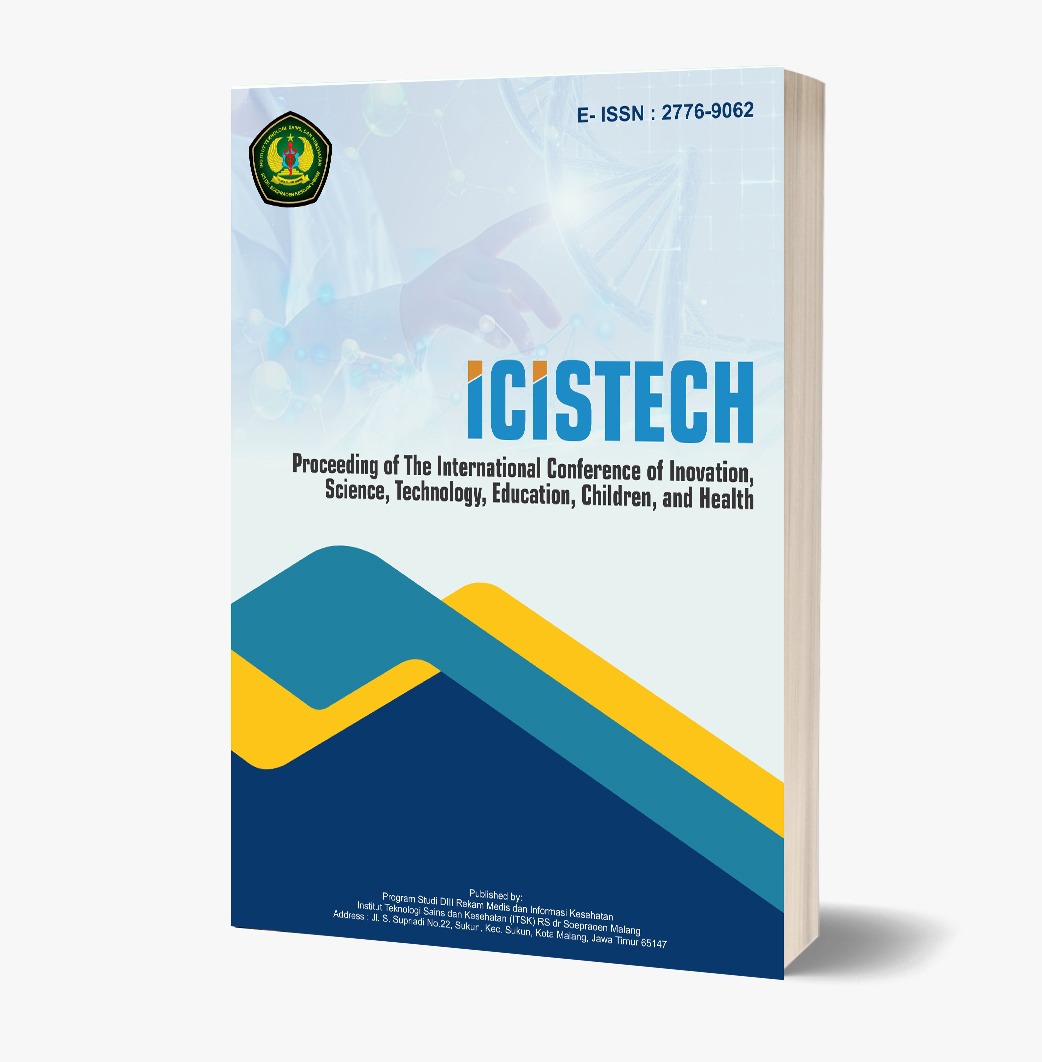Relationship between CED Status, Pregnant Women and LBW with Stunting Incidence in Toddlers at Dolodou Health Center, West Dumoga District
DOI:
https://doi.org/10.62951/icistech.v5i1.187Keywords:
Birthweight, Children, Nutrition, Pregnancy, StuntingAbstract
Stunting is a medical condition that significantly affects children's growth and development, resulting in long-term impacts on physical health, cognitive abilities, and productivity in adulthood. The problem often begins during pregnancy and early life, when nutrition and health care play a critical role in determining a child's developmental trajectory. This study aimed to analyze the relationship between the prevalence of stunting among toddlers in the operational area of the Dolodou Health Center UPTD and two key maternal and perinatal factors: chronic energy deficiency (CED) in pregnant mothers and low birth weight (LBW). A cross-sectional design was applied using a quantitative research approach. The study population consisted of all mothers with toddlers in the Dolodou Health Center area, and 31 respondents were recruited using a total sampling technique. Data were collected using structured questionnaires to gather information on maternal nutrition history, pregnancy conditions, and child anthropometric measurements. Chi-square statistical analysis was used to examine the relationships between variables. The results revealed a significant association between stunting and maternal CED status (p = 0.024), indicating that children born to mothers with chronic energy deficiency were at a higher risk of experiencing stunting. Additionally, children with a history of LBW were found to be more likely to suffer from stunting compared to those with normal birth weight. These findings underscore the importance of preventive measures during pregnancy, including nutritional monitoring, dietary supplementation, and health education to prevent both CED and LBW. In conclusion, addressing maternal nutritional health before and during pregnancy, along with continuous monitoring of child growth, is crucial to reducing stunting prevalence. Collaborative efforts between health workers, families, and the community are essential to ensure adequate nutrition and promote healthy development in children.
References
[Risk Factors for Stunting in the Karangdoro Health Center Area Semarang City]. (n.d.). [Nama Jurnal], 7, [halaman jika ada].
Alfarisi, R., Nurmalasari, Y., & Nabilla, S. (2019). Nutritional status of pregnant women can cause stunting in toddlers. [Nama Jurnal], 5(3),
Anggraini, H., Windari, F., Rosmawati, D., & Ningsih, T. R. (2024). Causing factors of low birth weight (LBW). Mandira Cendikia Health Science Journal, 3, [halaman jika ada]. https://journal-mandiracendikia.com/jikmc
Anggreni, D., Lubis, L. A., & Kusmanto, H. (2022). Implementation of stunting prevention program at Dolok Sigompulon Health Center, North Padang Lawas Regency. Journal of Social Sciences and Humanities, 1,
Anjani, D. M., Nurhayati, S., & Immawati. (2024). Application of health education to mother's knowledge about stunting in toddlers in the working area of UPTD Puskesmas Inpatient Banjarsari Metro North. Jurnal Cendikia Muda, 4,
Daracantika, A., Ainin, & Besral. (2021). Systematic literature review: The negative effect of stunting on children's cognitive development. Journal of Biostatistics, Population, and Health Informatics, 1(2), [halaman jika ada]. https://doi.org/10.7454/bikfokes.v1i2.1012
Hadina, H., Hadriani, H., Muliani, M., & Batjo, S. H. (2022). Efforts to prevent and handle stunting. Faletehan Health Journal, 9(2), 176–184. http://www.journal.lppm-stikesfa.ac.id/ojs/index.php/FHJ
Hapsari, Y. I., Rozi, F., Asyifa, N. F., Putranegara, S., & Balqis, S. P. (2022). Nutrition education and counseling for pregnant women with special economic zones. Bina Desa Journal,
Haryani, S., Astuti, A. P., Sari, K., Diploma, P., Nursing, T., & Waluyo, U. N. (2021). Stunting prevention through community empowerment with information and education communication in the village area of Candirejo, West Ungaran District, Semarang Regency. [Nama Jurnal], 4, [halaman jika ada]. http://jpk.jurnal.stikescendekiautamakudus.ac.id
Jannah, M., & Nadimin. (2021). The relationship of chronic energy deficiency (CED) in mothers with stunting incidence in toddlers in the work area of the Turikale Health Center. Health Media of Makassar Health Polytechnic, 16(2), [halaman jika ada]. https://doi.org/10.32382/medkes.v16i2.2421
Kamilia, A. (2019). Low birth weight with stunting incidence in children. Sandi Husada Scientific Journal of Health, 10(2), 311–315. https://doi.org/10.35816/jiskh.v10i2.175
Latifah, S., Munawarah, & Mahdalina. (2024). Effectiveness of stunting prevention and reduction program at Sungai Buluh Community Health Center, North Labuan Amas District, Hulu Sungai Tengah Regency. Public Service Journal, 1,
Ma’rupah, Rusmilawaty, Laili, F. J., & Suhrawardi. (2024). Determinants of stunting incidence in the Sebamban II Health Center work area. Journal of Multidisciplinary Research Nation, 1,
Mandu, J., Yuliaty, Farida, Rahmkiyati, A. L., Paramarta, V., & Wirawan, C. (2024). The role of environmental health management in reducing stunting cases in Bolang Itang Timur District, North Bolaang Mongondow Regency. Journal of Social Science Research, 4, 5114–5131.
Marlina, Tandiallo, D., & Ibrahim, F. (2024). Factors related to low birth weight (LBW) babies at Sawerigading General Hospital, Palopo. Health Journal Edition, 15(2),
Noviana, I., Bancin, F., & Zukrufa, H. (2023). The relationship between mother's knowledge about the First 1000 Days of Life (HPK) movement and the incidence of stunting in toddlers. All Fields of Science J-LAS, 3(3), 78–85. https://j-las.lemkomindo.org/index.php/AFoSJ-LAS/index
Purwitaningtyas, R., & Paramitha, I. A. (2024). Relationship between history of anemia and chronic energy deficiency (CED) of mothers during pregnancy with the incidence of stunting in toddlers in the work area of Buaran Public Health Center in 2023. SCIENTIST: Journal of Science, 4(2),
Rahayu, D., Putriningrum, R., & Yessy, M. (2024). Relationship between pregnant women with CED and stunting incidence in Pranggong Village. [Nama Jurnal], [volume(issue)],
Rismayana, & Sunarti, A. (2024). Description of chronic energy deficiency (CED) and anemia in mothers who have stunting toddlers aged 6–23 months in the Marawola Health Center working area for the 2020 period. Journal of Social Science Research, 4, 1992–1998.
Risnawati, I., & Munafiah, D. (2022). Stunting prevention efforts through providing balanced food and stunting massage. Jurnal Abdimas Indonesia, 4, 40–46.
Setiyawati, M. E., Ardhiyanti, L. P., Hamid, E. N., Muliarta, N. A. T., & Raihanah, Y. J. (2024). Literature study: Conditions and handling of stunting in Indonesia. [Nama Jurnal], 8(2), [halaman jika ada]. https://doi.org/10.37817/ikraith-humaniora.v8i2
Wahyuni, S. D., & Kusumodestoni, R. H. (2024). Optimization of support vector machine (SVM) algorithm in classification of stunting data events. Bulletin of Information Technology (BIT), 5(2), 56–64. https://doi.org/10.47065/bit.v5i2.1247
Yuwanti, L., Himawati, L., & Susanti, M. M. (2022). Stunting prevention in 1000 HPK. ABDIMAS-HIP Journal, 3
Downloads
Published
How to Cite
Issue
Section
License
Copyright (c) 2025 Proceeding of The International Conference of Inovation, Science, Technology, Education, Children, and Health

This work is licensed under a Creative Commons Attribution-ShareAlike 4.0 International License.













